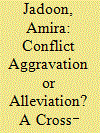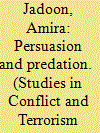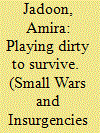|
|
|
Sort Order |
|
|
|
Items / Page
|
|
|
|
|
|
|
| Srl | Item |
| 1 |
ID:
188105


|
|
|
|
|
| Summary/Abstract |
Prior research on female participation in militant organizations explores organizational and individual factors that influence women’s recruitment, and the roles women fulfill. However, most research focuses either on transnational organizations or local militant groups. Within this study, we explore how linkages with transnational groups shape female participation within their overseas affiliate organizations. We employ an original dataset of female militants arrested or killed between 2014 and 2019 in the Philippines, Malaysia, and Indonesia, accounting for organizational affiliation. Overall, we find that female participation in militant groups increased between 2015 and 2017, with most of the increase associated with the Islamic State. While most women with an Islamic State association assumed non-combat roles, more than a third assumed combatant roles, indicating the influence of country-level and regional dynamics. Based on our data, female combatants with an Islamic State association served exclusively as either suicide attackers or conducted bombings, diverging from the varied roles assumed by women combatants in other groups in the region. Overall, our findings highlight how the nature of transnational organizations can combine with the local dynamics of their affiliate groups to produce unique trends in the local female militant landscape.
|
|
|
|
|
|
|
|
|
|
|
|
|
|
|
|
| 2 |
ID:
176095


|
|
|
|
|
| Summary/Abstract |
MILITARY AID RELATIONSHIPS ALLOW DONORS to avoid direct intervention and delegate the practical execution of their security goals to recipients. But recipients often fall short of meeting the security objectives that underpin military aid. Pakistan, which has received large amounts of military aid from the United States since September 11, 2001, has been consistently criticized by U.S. administrations for failing to do enough to dismantle terrorist networks. In 2018, the Donald Trump administration finally announced its decision to halt all security aid to Pakistan for playing a duplicitous role and providing sanctuaries to terrorists.1
|
|
|
|
|
|
|
|
|
|
|
|
|
|
|
|
| 3 |
ID:
164583


|
|
|
|
|
| Summary/Abstract |
Powerful states frequently employ foreign aid to pursue international security objectives. Yet aid's effectiveness will be undermined if it exacerbates the effects of conflict on civilians within recipient states. This article investigates how international development aid and U.S. military aid influence recipient governments' incentives and ability to target civilians. U.S. military aid has a persuasion effect on state actors, which decreases a recipient state's incentives and necessity to target civilians. Development aid flows, however, trigger a predation effect in some environments, exacerbating civilian targeting. An analysis of aid flows in 135 countries on civilian killings between 1989–2011 provides support for both the persuasion and predation effects associated with aid.
|
|
|
|
|
|
|
|
|
|
|
|
|
|
|
|
| 4 |
ID:
167186


|
|
|
|
|
| Summary/Abstract |
U.S. military aid provides recipient governments the fighting capability they require to undermine domestic militant groups, which can undermine groups’ leadership structures and trigger group splintering. In this environment, brutal attacks against non-combatants become an effective mechanism for targeted groups to signal their resolve and outbid competitors. A large-n analysis of U.S. military aid between 1989 -2011 links higher levels of military aid with higher levels of rebel-perpetrated civilian killings, and deaths due to explosive attacks on non-combatant targets. A closer examination of the case of Pakistan sheds further light on the underlying causal mechanisms.
|
|
|
|
|
|
|
|
|
|
|
|
|
|
|
|
| 5 |
ID:
188018


|
|
|
|
|
| Summary/Abstract |
Despite scholarly interest in the existence and consequences of the crime-terror nexus, little research has been done to examine how the presence of an illegal economic area, known as a shadow economy, impacts terrorist activity in a country. We propose a theory which argues that terrorists are able to rely on the partnerships and resources available in the shadow economy to increase their organizational capacity. Using data on terrorist activity and the size of the shadow economy, our empirical results show that the larger the shadow economy, the greater the number of overall terrorist attacks, fatalities, and certain types of mass-casualty events that a country experiences.
|
|
|
|
|
|
|
|
|
|
|
|
|
|
|
|
| 6 |
ID:
190762


|
|
|
|
|
| Summary/Abstract |
Research on the efficacy of leadership decapitation has focused primarily on targeting the topmost leaders of groups. Yet, most organizations rely on multiple leaders with specific functional or geographical responsibilities, rather than a single symbolic leader. In this context, we pose the following question: how are the effects of leadership decapitation on a group’s short-term operational capacity conditioned by the type or rank of targeted leaders? We argue that due to the risks faced by militant organizations, upper-tier leaders will delegate operational duties to lower-tier leadership for security purposes. Because of the shift of the principal-agent dynamic to lower-tier leaders, targeting of lower ranked leaders versus topmost leaders is more likely to result in a loss of control over foot soldiers, and trigger negative effects such as a rise in indiscriminate violence. We conduct our study using the case of Islamic State Khorasan in Afghanistan, with weekly data on the group’s attacks, and multi-tier leadership losses between 2015–2019 across 72 districts.
|
|
|
|
|
|
|
|
|
|
|
|
|
|
|
|
| 7 |
ID:
189447


|
|
|
|
|
| Summary/Abstract |
Transnational jihadist organizations, such as the Islamic State, have sought to reinforce their reputations by establishing new global affiliates. Islamic State affiliates, in particular, have leveraged preexisting militant infrastructures in new locations to create strategic partnerships with some militant organizations, while delegitimizing and attacking others as rivals. In this context, we pose the following question: what factors explain whether local groups will cooperate with an emergent transnational affiliate, or engage in a rivalry? We present a theoretical framework, which depicts how state sponsorship of militant groups, and the persistent rivalry between Al-Qaeda and the Islamic State, can combine to influence new inter-group relationships. Applying our typology to the case of Islamic State Khorasan in the Afghanistan-Pakistan region, we demonstrate that the more adversarial a local militant group’s relationship with the Pakistani state, and the weaker its historical relational proximity to Al-Qaeda, the more likely the group is to cooperate with ISK.
|
|
|
|
|
|
|
|
|
|
|
|
|
|
|
|
| 8 |
ID:
167879


|
|
|
|
|
| Summary/Abstract |
We theorize that foreign aid relationships influence both the effectiveness of economic sanctions threats and the aggressiveness of senders in imposing sanctions. Aid sanctions are generally far less costly for senders than imposing commercially oriented sanctions but can still be very costly for their targets. Being able to disrupt aid flows as part of potential sanctions enhances sender states’ credibility that they will impose painful sanctions against resisting target states. The more foreign aid a sender provides to a target state, the more successful we expect its sanctions threats to be and the more aggressive we expect the sender to be in imposing sanctions if the target resists. We test our theory using a competing risks analysis of ongoing, politically motivated sanctions threats issued by the United States from 1960–2010. Our analyses support our theory by revealing that the more foreign aid that the United States provides to target states, the more likely US sanctions threats are to succeed and the more aggressive the United States becomes in imposing sanctions.
|
|
|
|
|
|
|
|
|
|
|
|
|
|
|
|
|
|
|
|
|